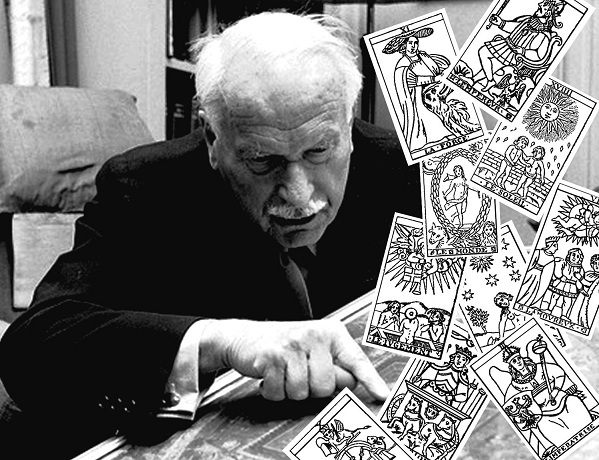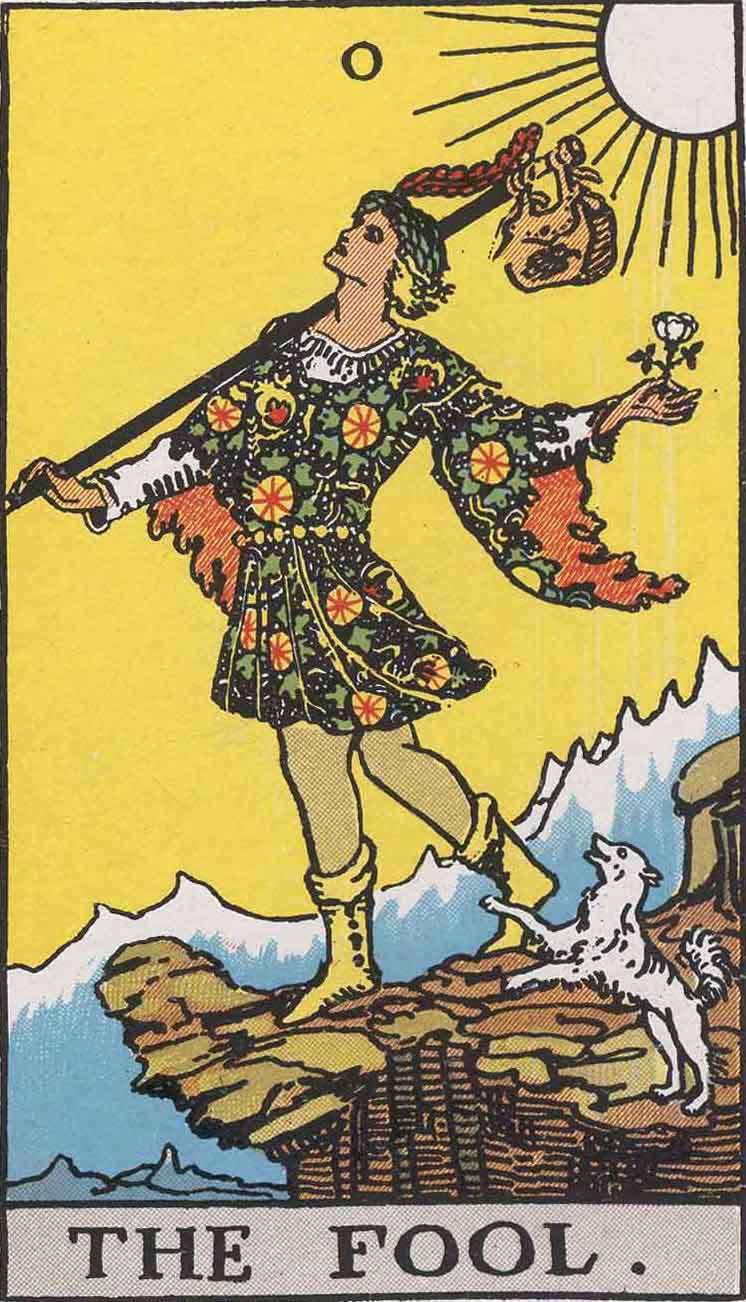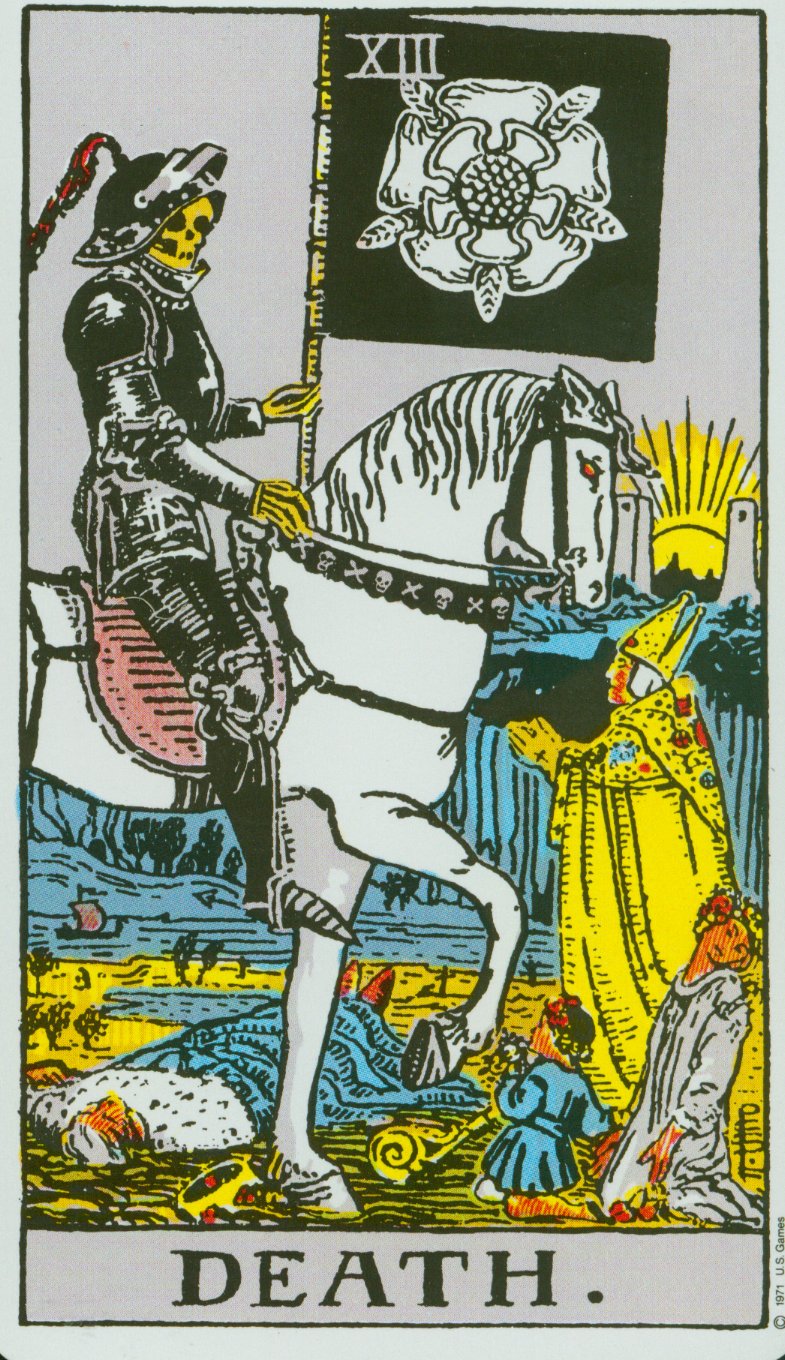
It is generally accepted that the standard deck of playing cards we use for everything from three-card monte to high-stakes Vegas poker evolved from the Tarot. “Like our modern cards,” writes Sallie Nichols, “the Tarot deck has four suits with ten ‘pip’ or numbered cards in each…. In the Tarot deck, each suit has four ‘court’ cards: King, Queen, Jack, and Knight.” The latter figure has “mysteriously disappeared from today’s playing cards,” though examples of Knight playing cards exist in the fossil record. The modern Jack is a survival of the Page cards in the Tarot. (See examples of Tarot court cards here from the 1910 Rider-Waite deck.) The similarities between the two types of decks are significant, yet no one but adepts seems to consider using their Gin Rummy cards to tell the future.
The eminent psychiatrist Carl Jung, however, might have done so.
As Mary K. Greer explains, in a 1933 lecture Jung went on at length about his views on the Tarot, noting the late Medieval cards are “really the origin of our pack of cards, in which the red and the black symbolize the opposites, and the division of the four—clubs, spades, diamonds, and hearts—also belongs to the individual symbolism.
They are psychological images, symbols with which one plays, as the unconscious seems to play with its contents.” The cards, said Jung, “combine in certain ways, and the different combinations correspond to the playful development of mankind.” This, too, is how Tarot works—with the added dimension of “symbols, or pictures of symbolical situations.” The images—the hanged man, the tower, the sun—“are sort of archetypal ideas, of a differentiated nature.”

Thus far, Jung hasn’t said anything many orthodox Jungian psychologists would find disagreeable, but he goes even further and claims that, indeed, “we can predict the future, when we know how the present moment evolved from the past.” He called for “an intuitive method that has the purpose of understanding the flow of life, possibly even predicting future events, at all events lending itself to the reading of the conditions of the present moment.” He compared this process to the Chinese I Ching, and other such practices. As analyst Marie-Louise von Franz recounts in her book Psyche and Matter:
Jung suggested… having people engage in a divinatory procedure: throwing the I Ching, laying the Tarot cards, consulting the Mexican divination calendar, having a transit horoscope or a geometric reading done.
Content seemed to matter much less than form. Invoking the Swedenborgian doctrine of correspondences, Jung notes in his lecture, “man always felt the need of finding an access through the unconscious to the meaning of an actual condition, because there is a sort of correspondence or a likeness between the prevailing condition and the condition of the collective unconscious.”

What he aimed at through the use of divination was to accelerate the process of “individuation,” the move toward wholeness and integrity, by means of playful combinations of archetypes. As another mystical psychologist, Alejandro Jodorowsky, puts it, “the Tarot will teach you how to create a soul.” Jung perceived the Tarot, notes the blog Faena Aleph, “as an alchemical game,” which in his words, attempts “the union of opposites.” Like the I Ching, it “presents a rhythm of negative and positive, loss and gain, dark and light.”

Much later in 1960, a year before his death, Jung seemed less sanguine about Tarot and the occult, or at least downplayed their mystical, divinatory power for language more suited to the laboratory, right down to the usual complaints about staffing and funding. As he wrote in a letter about his attempts to use these methods:
Under certain conditions it is possible to experiment with archetypes, as my ‘astrological experiment’ has shown. As a matter of fact we had begun such experiments at the C. G. Jung Institute in Zurich, using the historically known intuitive, i.e., synchronistic methods (astrology, geomancy, Tarot cards, and the I Ching). But we had too few co-workers and too little means, so we could not go on and had to stop.
Later interpreters of Jung doubted that his experiments with divination as an analytical technique would pass peer review. “To do more than ‘preach to the converted,’” wrote the authors of a 1998 article published in the Journal of Parapsychology, “this experiment or any other must be done with sufficient rigor that the larger scientific community would be satisfied with all aspects of the data taking, analysis of the data, and so forth.” Or, one could simply use Jungian methods to read the Tarot, the scientific community be damned.

As in Jung’s many other creative reappropriations of mythical, alchemical, and religious symbolism, his interpretation of the Tarot inspired those with mystical leanings to undertake their own Jungian investigations into parapsychology and the occult. Inspired by Jung’s verbal descriptions of the Tarot’s major arcana, artist and mystic Robert Wang has created a Jungian Tarot deck, and an accompanying trilogy of books, The Jungian Tarot and its Archetypal Imagery, Tarot Psychology, and Perfect Tarot Divination.
You can see images of each of Wang’s cards here. His books purport to be exhaustive studies of Jung’s Tarot theory and practice, written in consultation with Jung scholars in New York and Zurich. Sallie Nichols’ Jung and Tarot: An Archetypal Journey is less voluminous and innovative—using the traditional, Pamela Coleman-Smith-illustrated, Rider-Waite deck rather than an updated original version. But for those willing to grant a relationship between systems of symbols and a collective unconscious, her book may provide some penetrating insights, if not a recipe for predicting the future.
Related Content:
Alejandro Jodorowsky Explains How Tarot Cards Can Give You Creative Inspiration
The Tarot Card Deck Designed by Salvador Dalí
Twin Peaks Tarot Cards Now Available as 78-Card Deck
Josh Jones is a writer and musician based in Durham, NC. Follow him at @jdmagness


In all of Jung’s 8544 pages of collected works, we only find one sentence that he wrote about Tarot: ‘It also seems as if the set of pictures in the Tarot cards were distantly descended from the archetypes of transformation, a view that has been confirmed for me in a very enlightening lecture by Professor Bernoulli.’ (CW, 9.1, p.38). People have sold a whole lot of books implying that he was a lot more involved. Authors of interpretive books on Tarot ALWAYS need to be fact checked. There are a few reliable works, but most of the really reliable ones are the more scholarly works on playing card and Tarot card history.
The quotations from Jung here are sourced from seminar notes and a personal letter. The author who brought them to our attention has properly cited those sources and they are legitimate.
I have been followed by negative energy and have had nightmares and dream paralysis. No matter where I move it still happens. Please help?
Great article!
I’m also writing on the same topic and supporting the same assertions. Where can I source and site these quotes?
Thanx
Dear Dawn
I’m sorry to hear this, in my own experience sleep paralysis occurs when I’ve had a recent trauma — I believe this is due to a vulnerable aura at the time, and I take it as a sign to look after myself better, strengthen myself with healthy way of life. I hope this helps. Tiffany
I have had dreams recently where I am surrounded by black labrador dogs or puppies , their coats are really shiny ..can
you explain these dreams for me
Tyouhank
Geraldine
EVERYTHING Jung saw was about metaphor and the subconscious.
Peculiar that an entire article was written about something that this esteemed thought-leader mentioned only once; But nothing is EVER about what it seems to be about. (Remember that.)
I’m sure that the author’s interpretation is legitimate but I’m not sure it’s correct.
Then again, we can learn from everything. And if you know where to look, you can see the universe — and our relationships to it — in everything. Ask Liebnitz.
Dawn,
Try speaking to a primary care physician and possibly a qualified counselor about what you’ve been experiencing. They may be able to help you. Sometimes trauma causes these types of responses. And there are also some decent medications (when used properly) that can assist as well. Wishing you the best of luck!
Sorry. This article is biased, misleading and contains factual errors. Playing cards did not evolve from the tarot. Conventional playing cards appeared in Europe before the tarot. The tarot was created because a clever Italian wanted to have a trump suit for trick taking games. It is grossly negligent not to mention the historic role tarot has in gaming which give readers the false impression the cards are only used in divination.
The article also overstates the involvement Jung has with tarot. He actually wrote very little about it.
Read on here:
this URL please put without spaces,
as I have no clue how much-deformed link will be
after posting my comment.
h t t ps://removemagic*.*com
HINT: you are able to cleanse on your own,
unless you have too much money to spend.
Best of Luck!
Sir can you see when and.if my lawsuit is done and when will get it how much. Thank you
Playing cards predate tarot by hundreds of years. The history is very well-documented.
Carl based his archetypes on the house, read the red book. Unfortunately the archetypes are based on the planets, the tarot fits in better.
Who is teaching the use and translations of the cards?
Is there someone to contact who knows about teachers, workshops or seminars?
Thank you
Stephen
As another mystical psychologist, Alejandro Jodorowsky, puts it
”psychologist“ ???
William Arnaud
The article has a valuable content, which has helped me a lot in understanding Tarot Cards. I think if anyone wants to become expert in tarot card reader, then he needs to read your content consistently.
Josh,
You penned a wonderful fact-filled article. I am a clinical psychologist and have steeped in many mystical traditions (much to my benefit and that of my patients). For many years I have used astrology and tarot as adjunctive diagnostic and therapeutic tools with my clientele. The ability to encourage patients to use and draw upon rich symbolic images of tarot and astrology and co-mingle those sacred magics with heir own intuition and imagination offers a great deal of dimension and potential in the psycho=therapreutic surround. Mary Greer has authored a number of insightful and informative books on the rich symbolism and interpretive potentials of the tarot. I have also read from a number of credible sources that our modern playing cards are an abbreviated form of the tarot deck with the exception of the 22 Major Arcana cards, save for the Joker formerly known as “The Fool.”
Thank you for opening up a discussion on Jung, archetypes, symbols and creative consultations.
I like how tarot cards add symbols and pictures. Those can be a lot more accurate when trying to find out what your destiny is. But each symbol and picture can mean something different for each person.
The dog is usually an archetype of innocence, friendship and devotion. Especially when portrayed with such a kindly breed as the labrador. Tossing in one or more puppies sort of clinches this friendly archetype. Their shiny coats suggest spiritual illumination. I would therefore conclude there is a potently joyful aspect in your world or spirit, and you are a most fortunate person to have such a dream…having it more than once is quite a bonus!
You posted your query more than three years ago. I’m guessing something wonderful has occurred in your life later that year, 2018. Not necessarily outwardly, it could have something to do with a newfound, jubilant insight. At any rate, there is nothing but goodness in that type of dream.
May the Great Spirit be with you, always.
Bradford: You are absolutely correct.
Dr. Jung rarely mentioned “Tarot” in his Collected Works, Letters, Seminars, etc.
Only once in his Collected Works, once in his Collected Letters, Once in the Jung-Rhine Letters, Once in Children’s Dreams Seminar, Once in the Visions Seminar.
In is not a rare occurrence for person to utilize Dr. Jung’s name to validate or give an air of authenticity to assumptions, assertions and conclusions which could not otherwise stand on their own.
Thank you for your succinct statement.
Marie Louise von Franz who worked very closely with Carl Jung, wrote books on divination, alchemy and archetypes found in mythology and fairy tales.
No offense to everybody but Fortune telling has been around a long time a lot longer then tarot . It’s ridiculous to even think that something that complex would have been created before the basic 2–10 and J‑A method. They were first invented for fun not necessarily for fortune. Gypsies invented it and they weren’t suppose to be reading for vain reasons like love but for very rare occasions like court date or a very important affairs. My aunt alway made me get a brand new deck every time she said otherwise the spirits would lie to you suppose to get cards that haven’t been played with.She would give a reading with coffee and tell you what you were doing what time with who she would know your deep dark secrets that are embarrassing even for her just to say. She didn’t like doing it a lot because you are inviting spirits in your life doing so. When you ask you say things to yourself or aloud but directly to the spirit world . Some use to bring gifts to the gypsies instead of money I’m from a country that use to be a part of the USSR and if there is one thing people in Russia are it is very much so superstitious extremely . There are so many ridiculous superstition rules don’t put your purse on the bed or the table or floor . If you come back inside the house because you forgot something always look in the mirror single people should never sit in corners if a fork falls a man comes but if a knife comes it’s a woman don’t put an empty glass on the table because it mean money go out the door and on and on it goes look it up they spit on you or behind you on your path way over the shoulder to keep the devil away so many devil ones I mean a black cat crosses the street in front of you stop and spit behind your shoulder three times oy I mean Russians are ruled by superstition if you have a dream of a loved one calling you home not good means your going to die soon dream of fishes means money . It’s just never ending .
Your dreams sounds like the goddess the Hecate sisters, you can find more information online, they were white witches and very powerful.